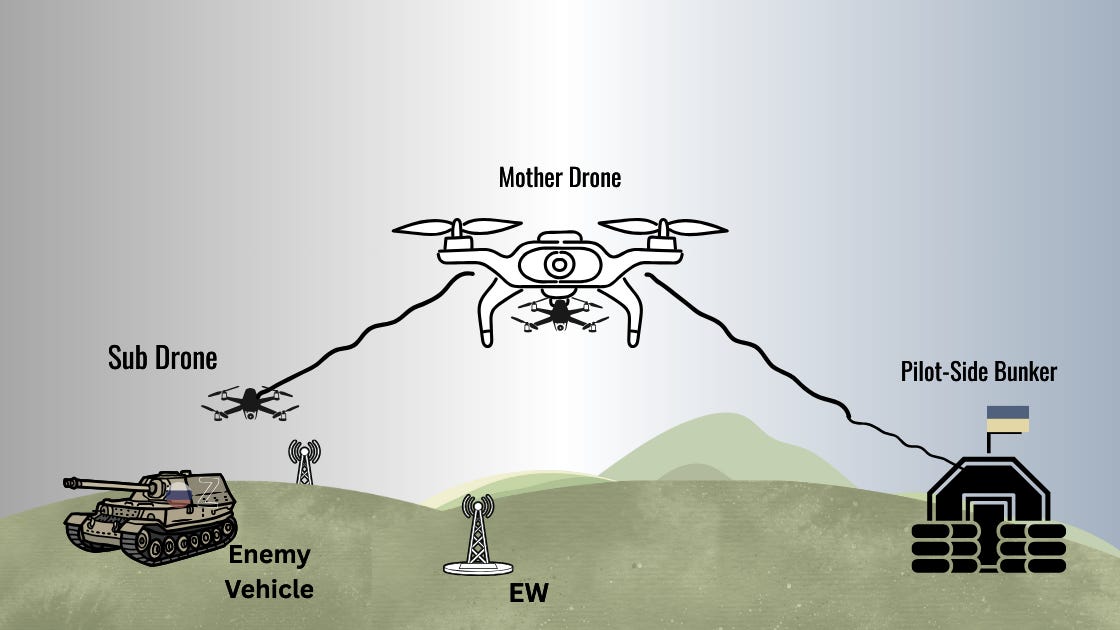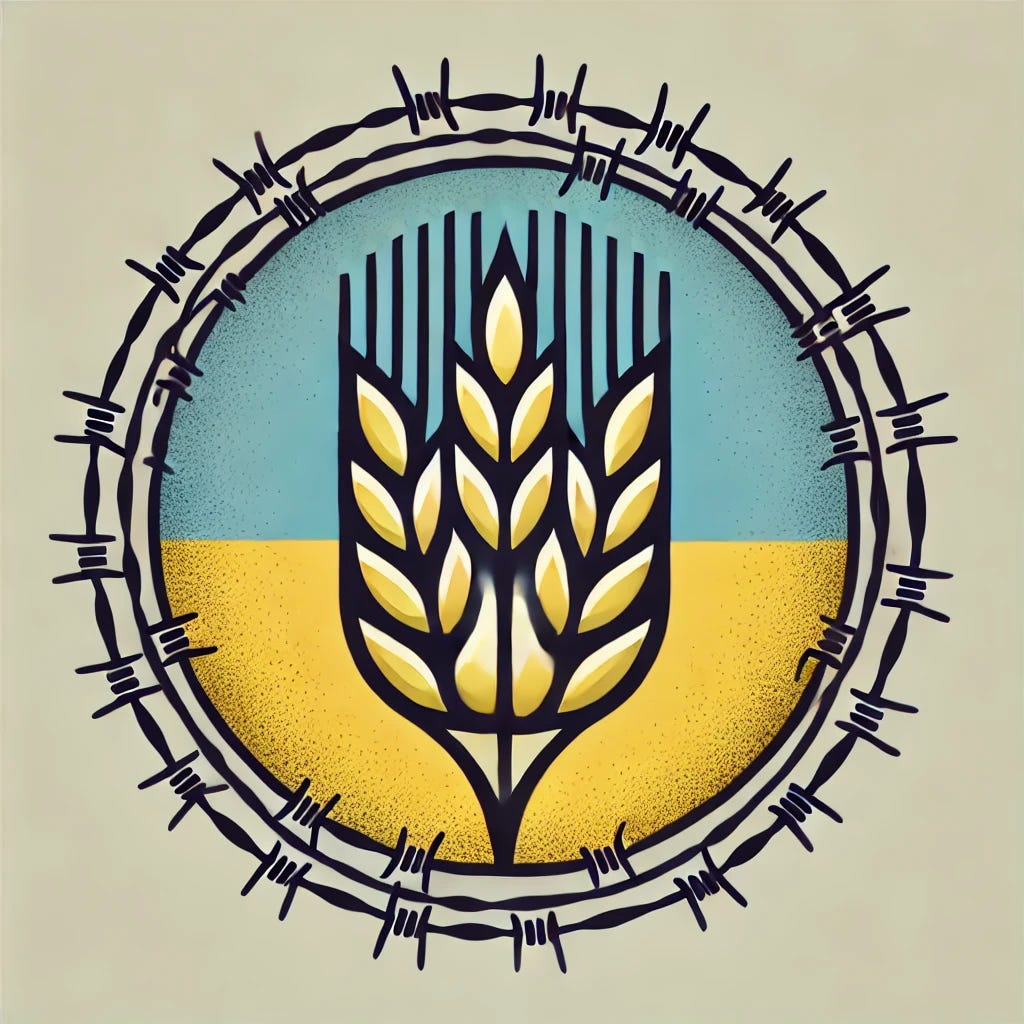NOTE: More times than not, if I think-up something interesting that just-might-work on the battlefield, Ukraine fields this good idea in a few months. Mother drones (this week’s buzz word) and leap-frogging drones into combat to gain range isn’t new on the battlefield of Ukraine. Relays extending range for UAVs isn’t new in Ukraine. Edge computing, trying to use AI to give you an advantage over your enemy isn’t new in Ukraine. But combining these concepts will be. Fiber Optic tethering is looked at by many as a less sophisticated version of drone combat. It’s what fighters are forced to rely on in heavily contested electronic warfare environments. In reality it’s the answer AI has been looking for. If you remove Edge Computing from the drone, connect it via fiber optics (low latency) you can have faster and better compute on the “Pilot-Side” than you could ever put on a small-cheap-drone. Pilot-side processing is the future. Fiber Optics makes it real. Leap-frogging your drone(s) into battle gives you the range.
Concept of Operations (CONOPS)
Pilot-Side AI Tethered Strike System (PATS)
A precision drone warfare platform with centralized AI processing, fiber-optic connectivity, and modular strike capability.
1. Purpose
This concept outlines the operation of a fiber-optic tethered drone strike system in which all computation (vision processing, target recognition, and guidance logic) is offloaded from the drone to a hardened, pilot-side ground station. The system is designed to operate effectively in electronic warfare (EW)-contested environments, reduce drone cost and weight, and increase precision and survivability through real-time human-on-the-loop AI control. By using tethered relays between a rear-area mother drone and forward-deployed sub-drones, the system enables extended strike operations—reaching deep into denied zones while maintaining control, fidelity, and security across distances of 40 km or more.
Hate Subscriptions? Me too! You can support me with a one time contribution to my research at Buy Me a Coffee. https://buymeacoffee.com/researchukraine
2. System Overview
a. Mother Drone
Octocopter or large multi-rotor UAV.
Carries a long-range fiber-optic tether (20–40 km).
Equipped with release mechanism for 2–3 sub-drones.
Contains no onboard AI processing; all control and data flow through tether to ground station.
b. Sub-Drones
Small FPV-style drones with designated roles:
ISR/Bomber drones (fragmentation, HE, or thermobaric payload).
Anti-armor drone (shaped charge/EFP).
Operate strictly via tethered fiber-optic connection to the mother drone and then to pilot-side AI.
Effective operational range from release point: 15–25 km depending on terrain and altitude.
c. Pilot-Side AI Ground Station
Located 20–40 km behind front lines.
Hosts AI-grade, high-throughput inference systems capable of parallel vision processing, tracking, and target analysis.
Handles all decision-making, removes need for any onboard processing.
Minimizes system vulnerability and keeps your "secret sauce" safe inside a bunker, not on a battlefield.
3. Mission Flow
Phase 1: Launch and Forward Positioning
The mother drone launches from a concealed or hardened position (e.g., vehicle, structure).
As it moves into position, it unreels fiber-optic tether back to the pilot-side control center.
The drone loiters or descends to conserve power while maintaining sub-drone deployment readiness.
Phase 2: Target Detection and Analysis
The drone’s optics feed real-time video back to the AI-enabled ground station.
Pilot-side AI performs automatic target recognition (ATR), object classification, and threat scoring.
A human operator reviews proposed targets and authorizes sub-drone deployment if conditions are met.
Phase 3: Sub-Drone Deployment
The mother drone releases one or more sub-drones toward the selected target area.
Sub-drones remain fiber-tethered throughout their mission.
Video and sensor feeds are continuously transmitted through the fiber to the pilot-side AI for real-time tracking and guidance.
Phase 4: Terminal Guidance and Engagement
In the final seconds of approach, pilot-side AI processes video to refine impact point selection.
Adjustments to flight path are calculated and transmitted through the tether to the sub-drone.
The sub-drone detonates its payload on the vulnerable point of the target (e.g., engine deck, turret ring).
Phase 5: Recovery or Loiter
The mother drone may return to base or loiter for further missions.
4. Key Capabilities and Advantages
Capability
Description
Pilot-Side AI
All computing resides with the operator, enhancing security, upgradability, and ease of deployment.
Low Latency Control
Fiber tether ensures sub-millisecond response time, enabling real-time corrections and tracking.
Reduced Onboard Burden
No AI chips or inference engines onboard; power and payload are dedicated to optics, motors, and munitions.
High-Precision Strike
Enables precision impact point selection, increasing lethality and reducing wasted ordinance.
Human-On-the-Loop Control
Human approves or cancels missions, but AI handles real-time execution and adjustments.
Cost Efficiency
Cheaper drones with higher-end optics; fewer losses from jamming, spoofing, or captured systems.
Scalability
Pilot-side AI system can simultaneously manage multiple mother drones and sub-drone strike units.
Superior Data Capture
Full-fidelity video and sensor logs can be archived pilot-side for AI model refinement and training.
Decentralized Manufacturing
Sub-drone architecture is simple and aligns with Ukraine’s distributed, volunteer-driven drone production ecosystem.
5. Operational Considerations
Bandwidth Requirements: 720p to 1080p at 30–60 fps is optimal for real-time targeting and AI processing. Compression may be used, but final-stage guidance benefits from raw or lightly compressed feed.
Redundancy: Optional multi-tether paths or secondary channels may be employed for failover in high-risk missions.
6. Key Take Aways
The Pilot-Side AI Tethered Strike System represents a shift in drone warfare design. It offloads intelligence from the airframe to a protected control point, reduces drone cost and complexity, and increases both operational precision and resilience in high-EW environments. This architecture supports a distributed, scalable, and highly lethal drone strategy tailored for the demands of modern, contested battlefields.
7. Known Limitations and Failure Points
a. Mechanical Complexity and Rotor Load
The mother drone must lift multiple subsystems: fiber spools, batteries, and sub-drones. This adds weight, increases rotor stress, and reduces endurance. Structural fatigue and instability are increased under wind, maneuvering, or sudden evasive movement.
b. Fiber Tether Vulnerability
Fiber tethers are immune to jamming but physically vulnerable. They can be cut, snagged, or crushed. They are sensitive to bending radius and must be deployed along predictable, clear paths. Environmental hazards (vehicles, debris, shrapnel) pose serious risks.
c. Tether Junction Node (Sub-Drone Interface)
The physical junction between mother drone and sub-drones introduces a failure point. While not electronic or latency-sensitive, this fiber connection must survive shock, vibration, moisture, and active movement. Misalignment or physical damage at this node will disable sub-drone control.
d. Data Throughput Bottleneck
Multiple high-resolution video streams may saturate the available bandwidth, depending on fiber spec and transceiver capacity. Tactical-grade systems may need parallel strands or buffered switching to avoid latency spikes or dropped frames.
e. Environmental Risk Factors
Fiber tether deployed across terrain must account for exposure to fire, changing terrain, and enemy movement. While not signal-loss zones, these are cable exposure corridors—areas where the physical link is at highest risk.
f. Deployment Complexity
The system requires deliberate planning and site preparation. Tether routing, AI unit protection, and operator station setup must be secure and shielded. This system is not suitable for fast-reaction, low-preparation missions and requires unit discipline and terrain control.
8. Future Development and Refinement Path
Continued development, field experimentation, and iterative combat testing of the PATS architecture may yield capabilities that significantly expand its strategic utility. Several enhancements are likely achievable in the next generation of deployment.
a. Extended Range Comparable to Artillery and Long-Range FPV
As fiber manufacturing, spooling systems, and launch logistics improve, total system range may increase from 40 km to 50–70 km.
This would place PATS in a superior position to long range 155 artillery.
Unlike RF-controlled FPV drones, tethered systems will not be constrained by line-of-sight, enabling reliable deep-strike missions into hardened EW zones.
b. Multi-Pilot Control Structure
A distributed pilot model can be implemented:
One operator controls and manages the mother drone’s ISR role, loiter behavior, and tether integrity.
Additional pilots or AI-assisted control stations can handle sub-drone targeting, routing, and terminal engagement.
This allows mission-specific tasking, simultaneous engagements, and dynamic load-sharing across a command node.
c. Loiter-Time Expansion Through Tether-Based Charging
Future mother drone tethers may incorporate a hybrid power-and-signal architecture that allows for:
Battery trickle charging while on station.
Long-duration ISR overwatch and drone “parking” above friendly-controlled areas.
This would extend mission times well beyond current battery constraints, especially for static surveillance or staging operations.
d. Secure Integration with Battlefield Management Systems
The physical tether ensures a secure, closed-loop data path immune to interception, spoofing, or jamming.
This closed-loop architecture opens opportunities unavailable to traditional RF or satellite-linked systems, such as:
Direct integration into national-level AI-assisted targeting systems (e.g., Delta and Avenger)
Seamless tasking and coordination with artillery, UAV, and infantry elements
Continuous, high-fidelity data streaming for real-time analysis and feedback
PATS can safely interface with protected battlefield networks while preserving operational security at every stage of the mission.
Benjamin Cook continues to travel to, often lives in, and works in Ukraine, a connection spanning more than 14 years. He holds an MA in International Security and Conflict Studies from Dublin City University and has consulted with journalists and intelligence professionals on AI in drones, U.S. military technology, and open-source intelligence (OSINT) related to the war in Ukraine. He is co-founder of the nonprofit UAO, working in southern Ukraine. You can find Mr. Cook between Odesa, Ukraine; Charleston, South Carolina; and Tucson, Arizona.
Hate Subscriptions? Me too! You can support me with a one time contribution to my research at Buy Me a Coffee. https://buymeacoffee.com/researchukraine
Mr. Cook’s Substack:








